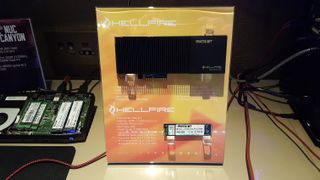Patriot Spark, Ignite, Hellfire And 2 TB Consumer SSDs
Patriot showed us a glimpse of what to expect in the second half of 2016 with three new consumer SSDs. The company plans to load the bases with new products that range from low-cost DRAMless solutions to high-performance NVMe. Second base goes to a new 2 TB mainstream SSD, but don't expect it to come home until Q4 2016.

The Patriot Spark leads off the trio. This DRAMless SSD attacks the field as a low-cost solution designed for true entry-level environments. Phison touched on the new S11 controller at CES, but more details emerged at Computex 2016.
“The Spark is a perfect entry level drive for those users looking to add a boost to their system,“ said Les Henry, Patriot’s VP of Engineering. “As many companies are just now coming out with their first generation TLC SSDs, the Spark is Patriot’s second generation TLC SSD Line.”
Later this week, we will detail DRAMless solutions from several controller makers and give our thoughts on performance, endurance and application workloads. The drives are ready for end users, system integrators and large OEMs, but we suspect limited device life will harm solid-state storage's reliability reputation and end user confidence in the technology.
Patriot claimed the Spark delivers up to 550 MB/s sequential read and 500 MB/s sequential write performance. Random performance should top 91,000 IOPS read and 86,000 IOPS write, at least for a few days of the product's life. This series should begin shipping soon, with prices of $34.99 (128 GB), $56.99 (256 GB), and $104.99 (512 GB).

The upcoming Ignite 2 TB is a bit more interesting for our readers and anyone looking for longer than two years of product life. Patriot launched this series in 120 GB to 960 GB already, so the new 2 TB model just extends the range. We talked about upcoming large capacity SSDs in our Computex SSD Preview editorial prior to the show but saw less than expected. It seems most of the companies will hold the product announcements for the holiday shopping season, although many have confirmed plans to bring larger than 1 TB capacity to market in 2016.
The latest Ignite features a Phison S10 controller, larger DRAM to address the capacity increase, and 15nm Toshiba MLC flash. Patriot can hit this capacity size by utilizing 16 die per package with 8 packages, or 16 packages with 8 die per package. Both configurations are fairly expensive, but we suspect the final selling price will be between $600 and $700.
Stay on the Cutting Edge
Join the experts who read Tom's Hardware for the inside track on enthusiast PC tech news — and have for over 25 years. We'll send breaking news and in-depth reviews of CPUs, GPUs, AI, maker hardware and more straight to your inbox.

Performance users can rejoice now that the Patriot Hellfire finally looks like a retail product. The Hellfire NVMe 1.2 SSD was displayed for the first time one year ago as a reference design. Patriot has done a lot of work with Phison to get this E7-powered product in shape for the big game.
Hellfire will ship in two configurations. The first is a simple M.2 SSD that scaled to 960 GB. We suspect the largest capacity size will require a 22110 form factor to accommodate the extra capacity. The 240 GB and 480 GB SSDs fit the 2280 form factor for notebook use.
| Product | Patriot Hellfire M.2 | Patriot Hellfire AIC |
|---|---|---|
| Form Factor | M.2 2280 / 22110 | PCIe Add-In Card |
| Sequential Read | 3,000 MB/s | 3,000 MB/s |
| Sequential Write | 2,200 MB/s | 2,200 MB/s |
| Random Read | 116,000 IOPS | 150,000 IOPS |
| Random Write | 210,000 IOPS | 230,000 IOPS |
Hellfire will also arrive in an add-in card (AIC) form factor, too, that can consume more power to deliver higher small block performance. The large heatsink aids in dissipating heat from the E7 controller. The firmware engineers can tweak the programming for a more stressful environment, and users can write more data before any thermal throttle events occur.
Patriot took notice when the OCZ RD400 reviews appeared online with the product having issues with Intel's PCIe RST driver. To show that the issue does not affect the Hellfire, the company put two M.2 drives in RAID and ran them in the new Intel Skull Canyon high-performance NUC. The performance was dashing, and we can't wait to play with our own pair in RAID. The combo may be just the kind of cleanup hitter Patriot needs to bring a bases-loaded lineup home.
MORE: Best SSDs For The MoneyMORE: Latest Storage News
MORE: Storage in the Forums
Chris Ramseyer is a Contributing Editor for Tom's Hardware, covering Storage. Follow him on Twitter and Facebook.
Most Popular







